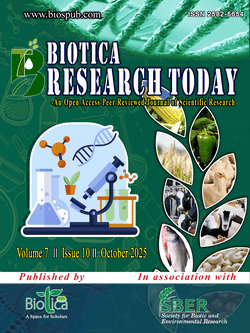
Biosensors for Sustainable Farming: Growing More with Less
Mummasani Asritha*
Dept. of Agronomy, Tamil Nadu Agricultural University, Coimbatore, Tamil Nadu (641 003), India
G. Gowtham
Centre for Agricultural Nanotechnology, Tamil Nadu Agricultural University, Coimbatore, Tamil Nadu (641 003), India
Sweetha V.
Dept. of Agronomy, Tamil Nadu Agricultural University, Coimbatore, Tamil Nadu (641 003), India
Kotresh D.J.
Dept. of Agronomy, University of Agricultural Sciences, Bengaluru, Karnataka (560 065), India
Sai Kumar Banoth
Dept. of Agronomy, Tamil Nadu Agricultural University, Coimbatore, Tamil Nadu (641 003), India
DOI: NIL
Keywords: Biosensors, Crop health, Precision farming, Smart agriculture
Abstract
Biosensors are predominant and an innovative tool in agriculture, offering farmers an easy go advance tool to monitor soil and crop health and environmental in real time. They are useful in monitoring vital parameters, including soil water content, nutrient conditions, pest and disease infestations, and taking correct and prompt decisions. Through biosensors, farmers are able to maximize irrigation and fertilizer utilisation, improve pest management and minimize loss of inputs that eventually results in high productivity and sustainability. In contrast to the traditional method of using observation and experience, biosensors provide reliable information that can aid in making decisions based on precision. Not only do they enhance the performance of crops, but also make the soil and the environment healthy by reducing resource wastage. However, the high prices and accessibility are still a problem especially among the small and marginal farmers. Biosensors are expected to be an inseparable component of sustainable and precise farming systems in the near future with the continued technological growth and reduction of the costs.
Downloads
not found
Reference
Aarif, K.O.M., Alam, A., Hotak, Y., 2025. Smart sensor technologies shaping the future of precision agriculture: Recent advances and future outlooks. Journal of Sensors 2025(1), 2460098. DOI: https://doi.org/10.1155/js/2460098.
Ahmed, Z., Gui, D., Murtaza, G., Yunfei, L., Ali, S., 2023. An overview of smart irrigation management for improving water productivity under climate change in drylands. Agronomy 13(8), 2113. DOI: https://doi.org/10.3390/agronomy13082113.
Dyussembayev, K., Sambasivam, P., Bar, I., Brownlie, J.C., Shiddiky, M.J.A., Ford, R., 2021. Biosensor technologies for early detection and quantification of plant pathogens. Frontiers in Chemistry 9, 636245. DOI: https://doi.org/10.3389/fchem.2021.636245.
Getahun, S., Kefale, H., Gelaye, Y., 2024. Application of precision agriculture technologies for sustainable crop production and environmental sustainability: A systematic review. The Scientific World Journal 2024(1), 2126734. DOI: https://doi.org/10.1155/2024/2126734.
Mondal, R., Dam, P., Chakraborty, J., Paret, M.L., Kati, A., Altuntas, S., Sarkar, R., Ghorai, S., Gangopadhyay, D., Mandal, A.K., Husen, A., 2022. Potential of nanobiosensor in sustainable agriculture: the state-of-art. Heliyon 8(12) e12207. DOI: https://doi.org/10.1016/j.heliyon.2022.e12207.
